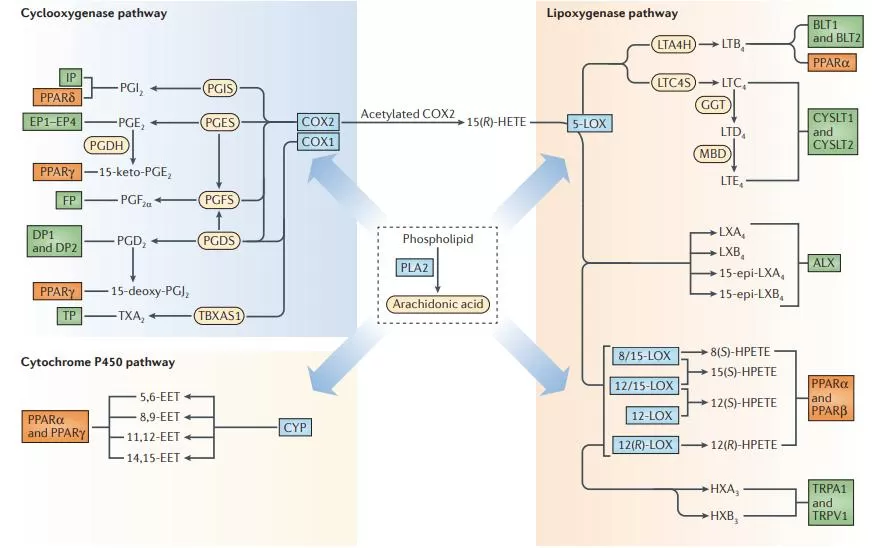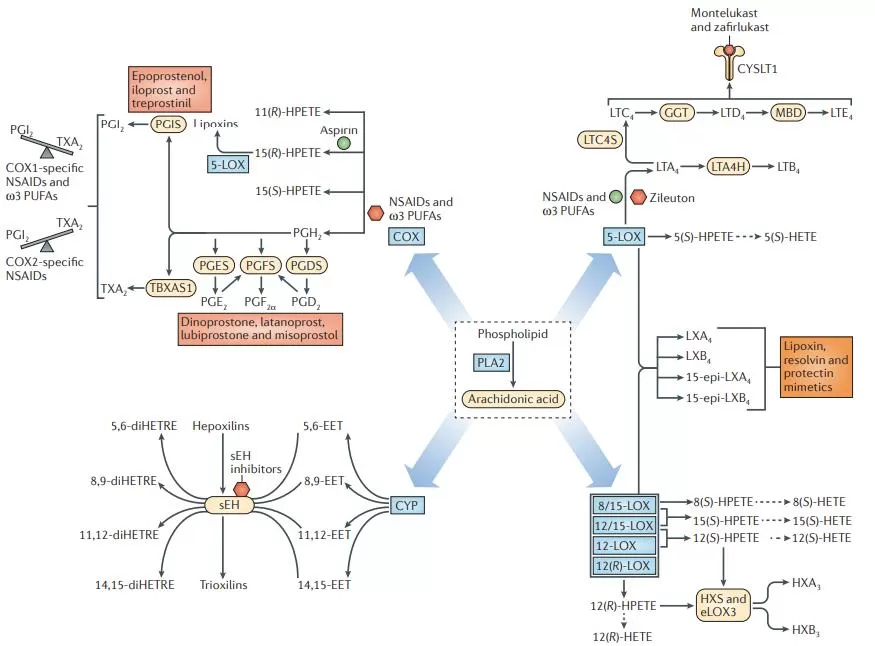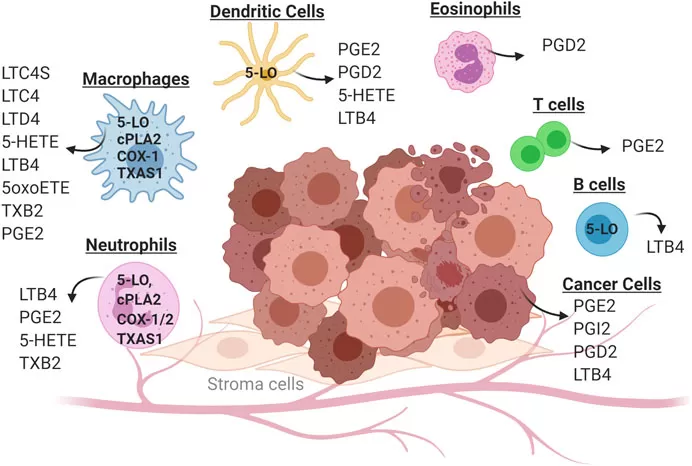Eicosanoids: Comprehensive Guide to Biosynthesis and Metabolism
Discover the intricate world of eicosanoids, bioactive lipid mediators with diverse functions in the body. From their biosynthesis to their role in health and disease, eicosanoids play a crucial role in inflammation, immune response, cardiovascular health, and cancer.
1.Biosynthesis of Eicosanoids
Eicosanoids are synthesized through the enzymatic oxidation of polyunsaturated fatty acids (PUFAs), primarily arachidonic acid (AA), eicosapentaenoic acid (EPA), and docosahexaenoic acid (DHA). The key enzymes involved in eicosanoid biosynthesis are cyclooxygenases (COX), lipoxygenases (LOX), and cytochrome P450 (CYP) enzymes. Understanding the pathways involved in eicosanoid synthesis, such as the cyclooxygenase (COX) pathway, lipoxygenase (LOX) pathway, and cytochrome P450 (CYP) pathway, provides insights into the complex interplay of these molecules in the body.
Cyclooxygenase (COX) Pathway
The COX pathway is responsible for the production of prostaglandins (PGs) and thromboxanes (TXs) from AA. This pathway is initiated by the enzyme phospholipase A2 (PLA2), which cleaves AA from the phospholipid membrane. The free AA is then converted into prostaglandin G2 (PGG2) through a series of enzymatic reactions.
The key enzyme in this pathway is cyclooxygenase (COX), also known as prostaglandin-endoperoxide synthase. COX catalyzes the oxygenation of AA to prostaglandin H2 (PGH2). There are two isoforms of COX: COX-1 and COX-2. COX-1 is constitutively expressed in most tissues and plays a role in maintaining homeostatic functions, such as gastric cytoprotection and platelet aggregation. In contrast, COX-2 is inducible and upregulated during inflammation and other pathological conditions. It is primarily responsible for the production of prostaglandins involved in pain, inflammation, and fever. PGH2, the common precursor, is further converted into various prostaglandins by specific synthases, such as prostaglandin E synthase (PGES) and prostaglandin F synthase (PGFS). These prostaglandins have diverse functions in the body, including regulation of inflammation, vascular tone, and reproductive processes.
Lipoxygenase (LOX) Pathway
The LOX pathway involves the enzymatic oxidation of AA, EPA, or DHA by lipoxygenase enzymes. LOX enzymes are classified based on their positional specificity of oxygenation on the fatty acid chain. For example, 5-lipoxygenase (5-LOX) primarily acts on AA, while 15-lipoxygenase (15-LOX) acts on both AA and EPA. In the LOX pathway, the fatty acid is converted into hydroperoxyeicosatetraenoic acids (HPETEs), which serve as intermediates for the synthesis of leukotrienes and lipoxins. 5-LOX converts AA to 5-HPETE, which is further metabolized into leukotriene A4 (LTA4). LTA4 can be enzymatically converted into various leukotrienes, such as leukotriene B4 (LTB4), leukotriene C4 (LTC4), and leukotriene D4 (LTD4). Leukotrienes are potent mediators of inflammation and immune response. They play important roles in allergic reactions, asthma, and other inflammatory diseases. Lipoxins, on the other hand, are anti-inflammatory in nature and contribute to the resolution of inflammation.
Cytochrome P450 (CYP) Pathway
The CYP route entails the cytochrome P450 enzymes' metabolism of PUFAs, mainly AA. In order to create epoxyeicosatrienoic acids (EETs) and hydroxyeicosatetraenoic acids (HETEs), these enzymes catalyze the oxygenation of AA. EETs have a significant role in controlling inflammation and vascular tone. They influence blood pressure regulation and have vasodilatory effects. On the other hand, HETEs display a variety of actions based on the particular metabolite and its site of action. While some HETEs have a role in the control of vascular tone and immune response, others have pro-inflammatory characteristics. The CYP enzymes CYP2C, CYP2J, and CYP2E are in charge of AA metabolism. These enzymes have tissue-specific expression patterns and help produce a variety of eicosanoids that are obtained from CYP.

2.Metabolism of Eicosanoids
Eicosanoids are rapidly metabolized to ensure the tight control of their signaling and biological activities. Several enzymatic pathways are involved in the metabolism of eicosanoids, including β-oxidation, ω-oxidation, and conjugation with glutathione or glucuronic acid.
β-oxidation is a major pathway responsible for the degradation of eicosanoids. It involves sequential oxidation of the fatty acid chain, leading to the generation of shorter-chain metabolites. This process occurs in peroxisomes and mitochondria and ultimately results in the production of water-soluble metabolites that are easily eliminated from the body. ω-oxidation is another important pathway involved in the metabolism of eicosanoids. It primarily occurs in the endoplasmic reticulum and involves the oxidation of the terminal carbon of the fatty acid chain. ω-oxidation leads to the formation of dicarboxylic acids, which are further metabolized or excreted. Conjugation reactions, such as glutathione and glucuronic acid conjugation, play a role in the detoxification and elimination of eicosanoids. These reactions enhance the water solubility of eicosanoids, facilitating their excretion through the urine or bile.
3.Dysregulated Eicosanoid Signaling and Diseases
Inflammation and Immune Response
Eicosanoids play a crucial role in modulating inflammation and immune responses. They can have both pro-inflammatory and anti-inflammatory effects, depending on the specific type of eicosanoid and its concentration. Pro-inflammatory eicosanoids, such as prostaglandins and leukotrienes, promote inflammation by increasing vascular permeability, attracting immune cells to the site of injury or infection, and inducing pain and fever.On the other hand, anti-inflammatory eicosanoids, such as lipoxins, resolvins, and protectins, help resolve inflammation and promote tissue repair. Eicosanoids are involved in both acute and chronic inflammation. In acute inflammation, eicosanoids mediate the initial response to injury or infection, whereas in chronic inflammation, dysregulated eicosanoid signaling can contribute to sustained inflammation and tissue damage, leading to chronic inflammatory diseases such as rheu matoid arthritis, asthma, and inflammatory bowel disease.

Cardiovascular Effects
Eicosanoids have profound effects on cardiovascular health, influencing blood pressure regulation and vascular tone. Prostaglandins, produced through the COX pathway, play a role in regulating blood pressure by modulating the balance between vasodilation and vasoconstriction. For example, prostacyclin (PGI2) is a potent vasodilator that helps maintain normal blood pressure, while thromboxane A2 (TXA2) is a vasoconstrictor and promotes platelet aggregation, increasing the risk of thrombosis. Imbalances in eicosanoid levels can contribute to cardiovascular diseases such as hypertension, atherosclerosis, and stroke. For example, an excess of pro-inflammatory eicosanoids can lead to vasoconstriction and hypertension, while a deficiency in anti-inflammatory eicosanoids can impair the resolution of inflammation and promote atherosclerosis.
Role in Cancer
Eicosanoids have been implicated in various aspects of cancer development and progression. Pro-inflammatory eicosanoids, such as prostaglandins and leukotrienes, can promote tumor growth, angiogenesis, and metastasis. For example, prostaglandin E2 (PGE2) has been shown to stimulate the growth of cancer cells, inhibit apoptosis (programmed cell death), and promote angiogenesis, thereby facilitating tumor progression. On the other hand, some eicosanoids, such as certain lipoxins and resolvins, have been found to have anti-cancer effects by inhibiting tumor cell proliferation, inducing apoptosis, and suppressing inflammation. Targeting dysregulated eicosanoid signaling pathways has emerged as a potential therapeutic strategy for cancer treatment. By modulating eicosanoid levels or blocking their receptors, it may be possible to inhibit tumor growth and metastasis and enhance the efficacy of existing cancer therapies.

4.Analytical Methods for Eicosanoid Detection
Chromatographic Techniques
Chromatographic techniques are widely used for the detection and quantification of eicosanoids due to their high sensitivity and specificity. High-performance liquid chromatography (HPLC) is a commonly used chromatographic technique for eicosanoid analysis. It allows for the separation of eicosanoids based on their chemical properties, such as polarity and molecular weight. HPLC coupled with ultraviolet (UV) or fluorescence detection can provide quantitative measurements of eicosanoid levels in biological samples. Gas chromatography-mass spectrometry (GC-MS) is another powerful technique for eicosanoid analysis. GC separates eicosanoids based on their volatility, and MS detects and quantifies the separated compounds based on their mass-to-charge ratio. GC-MS is highly sensitive and can identify and quantify a wide range of eicosanoids with high precision.
Immunoassays
Immunoassays are another important tool for eicosanoid detection, particularly for screening purposes. Enzyme-linked immunosorbent assay (ELISA) is a commonly used immunoassay for eicosanoid analysis. ELISA uses antibodies specific to eicosanoids to detect and quantify their levels in biological samples. ELISA is simple, fast, and can be used to analyze a large number of samples simultaneously.
Challenges and Advancements in Eicosanoid Analysis
Despite the advancements in analytical techniques for eicosanoid detection, there are still challenges associated with their analysis. One of the challenges is the complexity of biological samples, which can contain a wide range of lipid species that may interfere with eicosanoid detection. Sample preparation techniques, such as solid-phase extraction and derivatization, are often used to overcome this challenge. Advancements in eicosanoid analysis include the development of targeted lipidomics approaches, which allow for the simultaneous analysis of multiple eicosanoids and other lipid mediators. These approaches use advanced mass spectrometry techniques, such as liquid chromatography-tandem mass spectrometry (LC-MS/MS), to achieve high sensitivity and specificity.
5.MS-Based Eicosanoid Analysis
Mass spectrometry (MS) has revolutionized the field of lipidomics, enabling the sensitive and accurate analysis of eicosanoids. MS-based approaches allow for the identification, quantification, and structural characterization of eicosanoids, providing valuable insights into their roles in health and disease.
Liquid chromatography coupled with tandem mass spectrometry (LC-MS/MS) is commonly employed for eicosanoid analysis. It offers high sensitivity, selectivity, and the ability to analyze multiple eicosanoids simultaneously. Isotope-labeled internal standards are used for quantification, ensuring accurate measurements of eicosanoid concentrations. Advanced MS techniques, such as high-resolution mass spectrometry (HRMS) and imaging mass spectrometry (IMS), further expand the capabilities of eicosanoid analysis. HRMS enables the identification of unknown eicosanoids and the elucidation of their structures. IMS allows for the spatial visualization of eicosanoid distribution within tissues, providing valuable insights into their localizations and roles in specific physiological processes or disease states. MS-based eicosanoid analysis facilitates the discovery of novel eicosanoids, the investigation of their biosynthesis and metabolism, and the assessment of their perturbations in various diseases. It serves as a powerful tool for researchers and clinicians aiming to understand the complex interplay of eicosanoids and develop targeted interventions for eicosanoid-related disorders.
6.Clinical Implications and Therapeutic Potential
Eicosanoids as Drug Targets
Eicosanoids have long been recognized as important mediators of inflammation and immune responses, making them attractive targets for drug development. Current drugs targeting eicosanoid pathways include nonsteroidal anti-inflammatory drugs (NSAIDs), which inhibit the activity of cyclooxygenases (COX) and reduce the production of pro-inflammatory prostaglandins. However, these drugs can have side effects, such as gastrointestinal bleeding and cardiovascular risks. Future prospects for novel therapeutics include developing selective inhibitors of specific eicosanoid biosynthetic enzymes, such as COX-2 inhibitors, which may offer improved efficacy and safety profiles compared to traditional NSAIDs.
Diagnostic and Prognostic Value
The analysis of eicosanoid profiles in biological samples has shown promise in disease diagnosis and prognosis. Changes in eicosanoid levels have been associated with various diseases, including inflammatory disorders, cardiovascular diseases, and cancer. By analyzing eicosanoid profiles, clinicians may be able to identify biomarkers for early disease detection and monitoring. Eicosanoids also have predictive value in monitoring treatment responses. For example, monitoring changes in eicosanoid levels in response to anti-inflammatory therapies can help assess the efficacy of treatment and guide personalized therapeutic strategies.
Discover More with MetwareBio
In conclusion, eicosanoids are critical regulators of physiological and pathological processes in the body. Understanding their complex biology and role in disease opens up new avenues for therapeutic interventions and personalized medicine.
Read More:


